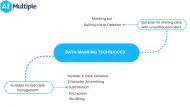Data Interoperability & Machine Learning in 2024 & Beyond
Modern business systems are integrated, and if an AI-powered solution is added to a business’s digital mix, it needs to have the ability to work together with all the other software and tools. AI and machine learning interoperability gives that level of integration to AI-powered digital solutions. However, to achieve this interoperability, AI/ML models need to have the ability to exchange data and interact with each other. That is where data interoperability comes into play.
If you wish to achieve data interoperability in your business to leverage interoperable machine learning, this article is for you. In this article, we explore data interoperability, why it’s important for interoperable AI solutions, and what are its different types to help business leaders achieve interoperability across their digital network.
What is data interoperability?
Data interoperability is the ability of two or more systems, applications, data stores, or microservices to exchange data and interact with each other. Interoperability enables data transfer between different types of data sources, ensuring that data is accessible across a variety of formats and platforms. This allows organizations to leverage data from disparate sources for things such as analytics and data visualization, data integration, and data sharing.
What are the types of data interoperability?
There are two main types of data interoperability:
- Data-level interoperability: Data-level or syntactic interoperability enables data to be shared across applications and platforms.
- Semantic-level interoperability: This type of interoperability allows the data to be interpreted correctly by different machine-learning systems.
Why is data interoperability important?
Data interoperability is important for organizations because it enables data to be accessible across different formats and platforms. This helps organizations make data-driven decisions, reducing costs, increasing operational efficiency, and improving customer experience.
Organizations nowadays work with tens of thousands of data points, and it can be beneficial for them to use them in a synergistic way. Data interoperability enables AI/ML systems to communicate with other systems to produce more accurate and extensive results.
For instance, an interoperable automated invoicing system will have the option to share the invoices with other systems (procurement, inventory management, ERP, PIM systems, etc., in different formats that are compatible with those systems.
Which industries can benefit from data interoperability?
1. Healthcare
Data interoperability in the healthcare industry allows data from multiple sources (e.g., patient records, medical devices, imaging data, etc.) to be collected and shared for better diagnosis and treatment of patients.
Data interoperability in healthcare:
2. Manufacturing
Data interoperability in the manufacturing industry enables data from machines, robots, and other equipment to be collected and shared for better production processes and quality control.
3. Financial Services
Data interoperability in financial services helps organizations manage risk by collecting data from a variety of sources, such as customer data, market data, transaction data, etc. This enables institutions to make smarter decisions about investments and pricing strategies.
4. Education
Data interoperability in the education sector enables data from multiple sources (e.g., student data, teacher data, course data, etc.) to be collected and shared for better decision-making about curriculum planning and personalized learning.
Here is a video of how data interoperability works in an educational setting:
3 Steps to achieve data interoperability
Step 1
Data-level interoperability can be achieved through data integration platforms such as data warehouses and data lakes. These platforms allow data to be collected from different sources, stored in a single unified repository, organized, and accessed in various formats. This is necessary because it enables systems to adopt common data formats and structural protocols. The data can then be accessed and applied to various analytics tools and used for machine learning tasks.
Step 2
This step helps the different systems understand each other’s data. Semantic-level interoperability can be achieved by adding information about the data (metadata) and connecting each data element to a standardized, common vocabulary. This process also involves annotating and labeling the data.
Additionally, data standards can also be used to ensure that data from multiple sources can be accessed and interpreted correctly by different AI systems. This helps organizations create uniform datasets that are consistent across various data sources.
Step 3
Now, the data vocabulary needs to be established and linked to an ontology. In order to link a vocabulary to an ontology, two approaches can be used:
- Data mapping: Which involves connecting data elements from different formats into one unified data structure.
- Data federation: Which is a technique that allows data stored in multiple data sources to be shared and accessed as if it were stored in a single data source.
Through these standards, businesses can share relevant data without relying on another information system.
If you wish to learn more about how to collect data for interoperable systems, feel free to download our comprehensive data collection whitepaper:
Further reading
- Multimodal Learning: What it is, Benefits & 3 Real-World Examples
- Automated Data Labeling: What it is, Benefits & Challenges
If you need help finding a vendor or have any questions, feel free to contact us:



Comments
Your email address will not be published. All fields are required.